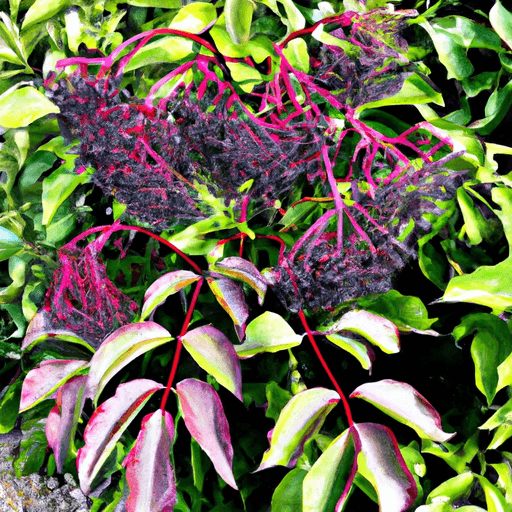Black Lace® elderberry is a popular shrub known for its stunning dark foliage and delicate pink flowers. In this article, readers will discover essential tips for successfully growing and caring for Black Lace® elderberry.
From ideal growing conditions to soil and watering requirements, this comprehensive guide will provide all the necessary information to ensure the health and vitality of this beautiful plant.
Additionally, readers will learn about pruning techniques, propagation methods, and how to deal with pests and diseases.
Get ready to cultivate a thriving Black Lace® elderberry garden with these expert tips.
Ideal Growing Conditions
Black Lace® elderberry thrives in full sun, especially in the northern regions, but it can tolerate partial shade in the North and benefit from some afternoon shade in the southern end of its range.
Adequate sunlight is essential for flower and berry production, so it’s important to adjust the planting location based on the amount of sunlight available.
This elderberry shrub tolerates clay soil types well and performs better over time when planted in well-drained soil. It prefers slightly acidic soil but can grow adequately in neutral soil.
Regularly monitor soil moisture levels to ensure optimal growth and keep the soil evenly moist for Black Lace® elderberry. This shrub can tolerate wet soil better than many other plants, so provide at least 1 inch of water per week, combining rainfall and irrigation.
Proper watering helps promote healthy growth and berry production.
Soil and Watering Requirements
Adequate sunlight is crucial for the healthy growth and berry production of the Black Lace® elderberry shrub. However, soil pH also plays an important role in the overall health and vigor of this plant.
Black Lace® elderberry prefers slightly acidic soil, but it can still grow adequately in neutral soil. It is important to consider the soil pH when selecting a planting location for this shrub.
In terms of watering, Black Lace® elderberry requires regular monitoring of soil moisture levels to ensure optimal growth. The soil should be kept evenly moist, as elderberry shrubs tolerate wet soil better than many other plants. It is recommended to provide at least 1 inch of water per week, combining rainfall and irrigation.
Proper watering techniques are essential to promote healthy growth and berry production in Black Lace® elderberry.
Varieties and Pruning Tips
‘Laced Up®’ is a cultivar of elderberry that has feathery purple-black foliage and a columnar growth habit. When it comes to pruning techniques for elderberries, it is important to note that they should be avoided for the first two years to allow for full growth development.
However, after this initial period, pruning can be done in late winter or early spring before new growth begins. This will help promote flower and fruit production. It is recommended to remove older, weaker stems to direct energy into newer, more attractive stems. Regular pruning not only keeps the plant vigorous and attractive but also prevents excessive spreading.
As for varieties for different climates, besides ‘Laced Up®’, other cultivars of black elderberry include ‘Marginata’, ‘Aureomarginiata’, ‘Instant Karma®’, and ‘Black Beauty®’. These varieties offer different foliage colors and growth habits, making them suitable for a range of climates.
Propagation and Overwintering Guidelines
To ensure successful propagation and overwintering of elderberry shrubs, it is important to follow proper guidelines for planting, protecting, and maintaining the plants.
When it comes to propagation techniques, it is crucial to note that propagating Black Lace® elderberry is a violation of copyright law. However, other black elderberry varieties can be propagated through rooted suckers or seedlings. It is essential to check if the plant you want to propagate is trademarked to avoid any legal issues.
Additionally, it is recommended to protect elderberry shrubs from winter damage by using wire cages and removing debris from under the shrubs to prevent reinfection by fungal spores. Applying a layer of dry, sterile mulch can also protect the root zone during winter. Extra winter protection, especially during the first year or two, is advised.
Dealing With Pests, Diseases, and Promoting Blooming
Proper pruning and regular monitoring of the plant’s health are key to preventing and addressing pest and disease issues, while ensuring optimal blooming of the elderberry shrub.
Elderberries are susceptible to various insect pests such as aphids, borers, and spider mites. To address infestations, neem oil can be an effective option.
Fungal diseases like canker, leaf spot, and powdery mildew can also affect elderberries. To prevent these diseases, it is important to promote good air circulation by maintaining proper spacing between plants, avoid overhead spraying, and keep mulch away from the main stems.
Additionally, providing the plant with adequate sunlight and following proper care practices, including watering, fertilizing, and pruning, will help promote blooming. Planting another elderberry cultivar nearby can increase pollination and enhance blooming as well.
Regular monitoring of the plant’s health and addressing any issues promptly is crucial for optimal blooming.
Additional Tips and Information
Mulching around the base of the elderberry shrub helps to retain soil moisture and protect the roots during winter.
In addition to these essential care practices, there are other ways to maximize the benefits of Black Lace Elderberry in the garden.
One creative use is companion planting with other plants that complement its growth habits and provide additional benefits.
For example, planting Black Lace Elderberry alongside flowering perennials can attract pollinators, such as bees and butterflies, which are crucial for fruit production.
Additionally, the vibrant purple-black foliage of Black Lace Elderberry can create a striking contrast when planted next to shrubs with brightly-colored leaves, adding visual interest to the garden.
These creative uses not only enhance the aesthetic appeal of the garden but also provide ecological benefits by supporting pollinators and attracting wildlife.







